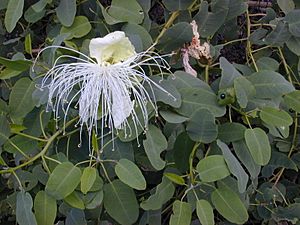Capparis sandwichiana facts for kids
Quick facts for kids Capparis sandwichiana |
|
|---|---|
 |
|
| Conservation status | |
| Scientific classification | |
| Genus: |
Capparis
|
| Species: |
sandwichiana
|
Capparis sandwichiana is a special kind of flowering plant that grows only in the Hawaiian Islands. It's often called maiapilo, pua pilo, or Hawaiian caper. This plant is part of the Capparaceae family, which includes other caper plants.
You can find the Hawaiian caper on the main islands of Hawaii, as well as on smaller islands like Midway Atoll, the Pearl and Hermes Atoll, and Laysan. It likes to grow in sunny, dry places near the coast, like rocky shores or low shrublands. It can be found from sea level up to about 100 meters (325 feet) high.
Sadly, the Hawaiian caper is a vulnerable plant. This means it's at risk of disappearing. Things like animals eating the plants, other plants taking over its space, and losing its natural home are big problems for it.
Contents
About the Hawaiian Caper Plant
The Hawaiian caper is a unique plant that has adapted to living in the tough coastal environments of Hawaii. It's known for its interesting flowers and fruits.
What Does it Look Like?
The Hawaiian caper plant can grow as a small shrub or a vine. It has green leaves and beautiful flowers that usually open in the evening. These flowers are often white or yellowish and have many long stamens, which are the parts that hold pollen.
After the flowers bloom, they produce round or oval fruits. These fruits are green at first and turn a reddish-purple color when they are ripe. Inside the fruit are many small seeds.
Where Does it Grow?
This plant is an endemic species, which means it naturally grows only in the Hawaiian Islands and nowhere else in the world. It's a true native of Hawaii.
It prefers dry, sunny spots along the coast. You might see it growing on lava flows, sandy beaches, or rocky cliffs. It's very tough and can handle the salty air and strong winds near the ocean.
Why is it Important?
The Hawaiian caper is an important part of the Hawaiian ecosystem. Native plants like this provide food and shelter for local insects and birds. They also help to prevent soil erosion, especially in coastal areas.
For a long time, native Hawaiians have used plants like maiapilo for different purposes. While specific traditional uses for Capparis sandwichiana are not widely documented, many native plants were used for medicine, food, or other daily needs.
Protecting the Hawaiian Caper
Because the Hawaiian caper is vulnerable, efforts are being made to protect it. It's important to understand the threats it faces to help it survive.
What are the Threats?
One big threat is grazing. Animals like goats and cattle, which were brought to Hawaii by people, eat the young plants and prevent them from growing.
Another problem is invasive species. These are plants that are not native to Hawaii but have been introduced there. They grow very fast and can take over the space that the Hawaiian caper needs, competing for sunlight, water, and nutrients.
Habitat destruction is also a major concern. When coastal areas are developed for buildings or tourism, the natural homes of these plants are destroyed. Climate change, which can lead to rising sea levels and more extreme weather, could also affect its habitat.
How Can We Help?
Protecting the Hawaiian caper involves several steps. Scientists and conservationists are working to:
- Control grazing animals in areas where the plant grows.
- Remove invasive plants that compete with the Hawaiian caper.
- Protect coastal habitats from development.
- Grow new Hawaiian caper plants from seeds in nurseries and then plant them back into the wild.
By learning about and protecting plants like the Hawaiian caper, we can help keep Hawaii's unique natural environment healthy for future generations.
See also
 In Spanish: Capparis mariana para niños
In Spanish: Capparis mariana para niños


